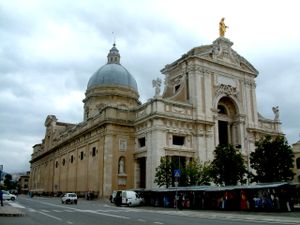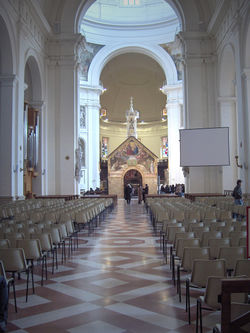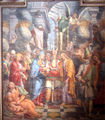Basilica of Santa Maria degli Angeli
2007 Schools Wikipedia Selection. Related subjects: Architecture
The Basilica of Santa Maria degli Angeli (Saint Mary of the Angels) is a church situated in the plain at the foot of the hill of Assisi, Italy.
The basilica was constructed between 1569 and 1679 enclosing the 9th century little church, the Porziuncola, the most sacred place for the Franciscans. It was here that the young Francis of Assisi understood his vocation and renounced the world in order to become a poor among the poor and thus started the Franciscan movement.
History
After the death of Saint Francis in 1226, the friars built several small huts around the Porziuncola. In 1230 a refectory and some adjacent buildings were added. In the course of time little porticoes and accommodations for the friars were added around the Porziuncola. (some foundations of these were discovered during excavations under the floor of the present basilica between 1967 and 1969).
As more and more vast numbers pilgrims came flocking to Assisi to receive the “Pardon of Assisi”, the small space of the Porziuncola became completely inadequate to house all these pilgrims. The necessity grew to build a church incorporating the Porziuncola. The buildings around the shrine were taken down by order of pope Pius V (1566-72), except the Chapel of the Transito, the cell in which St. Francis had died. Construction of the basilica started on 25 March 1569, This majestic church, the seventh largest Christian church, was designed in an Italian pre-Baroque style by the famous architect Galeazzo Alessi (1512-1572), assisted by Jacob Barozzi, also called Vignola (1507-73). The work progressed slowly, due to continuous lack of money as the building was financed with donations. The dome was finished in 1667. This dome, resting on an octagonal drum with eight windows and cornices, is an architectural work of art. Construction of the church was finally finished in 1679. In 1684 a bell tower was added. It was originally intended to have a twin tower, but the second was never built.
On 15 March 1832 the central nave, a part of a lateral aisle and the choir collapsed during a violent earthquake. The dome, the only surviving work of Alessi, escaped destruction, but was left with a wide crack. The apse and the side chapels were left standing. Reconstruction of the basilica started in 1836 by the architect Luigi Poletti and it was finished in 1840. He had remodeled the façade in a neoclassical style. Between 1924 and 1930 this façade was given back its original pre-Baroque style by Cesare Bazzani. The gold-plated statue of the "Madonna degli Angeli" (Madonna of the Angels) by the sculptor Colasanti, was put on top of the façade in 1930.
On 11 April, 1909, the church was raised by pope Pius X to the status of "patriarchal basilica and papal chapel"
Description
The basilica has a rectangular ground plan, divided into a central nave and two lateral aisles, flanked by ten side chapels, with at the far end a transept, and a long choir in a semi-circular apse, protruding from the ground plan. The Porziuncola is situated directly under the dome. The church is 126 meters long, 65 meters large and the dome is 75 meters high. The interior is simple and yet elegant with only a few decorations, in stark contrast with the decorations of the side chapels. The nave and the aisles were rebuilt in neoclassical Doric style by Luigi Poletti. The apse holds the precious wooden choir, carved by Franciscan brothers starting in 1689, the papal cathedra (with bas-reliefs by E. Manfrini) and the papal altar. The Chapel of the Transito, the cell in which St. Francis died, is still preserved. It is situated under the bay of the choir, against the right columns of the dome.
The side chapels were decorated by great artists from several periods
- Antonio Circignani “Pomarancio”'(c. 1570 – 1630) (all paintings in the Chapel of St Anne ) (1602-1603)
- Antonio Maria Garbi (Chapel of St Diego D’Alcalà) (1773)
- Baldassarre Croce (1563-1638) (all paintings in the Chapel of St Pius V) (1602-1603) (Chapel of the removal of the Lord) (1602)
- Baldassarre Orsini (Chapel of St Diego D’Alcalà) (1787), (Chapel of Our Lady of the Rosary)
- Brother Ippolito da Coceto (Chapel of St Diego D’Alcalà) (1710) and the ovals on the Altar of the Holy Cross
- Antonio Cavallucci (1752-1795) (Chapel of St Diego d’Alcalà)
- Cesare Sermei (c.1609 – 1668) (Chapel of the Stigmata) (1630)
- Crispolti (Chapel of the Removal of the Lord) (1602)
- Domenico Maria Muratori (1661-1774) (Chapel of Our Lady of the Rosary)
- Francesco Appiani (1704-1793) (Chapel of St. Anthony -1756 and Chapel of St. Peter in Chains – 1760)
- Garbi (Chapel of St Anthony - 1773)
- Giacomo Giorgetti (all paintings in the Chapel of St John the Baptist) (Chapel of the Stigmata) (1630)
- Gian Domenico Mattei (Chapel of St Peter in Chains)
- Giorgetti di Assisi (the frescoes in the vault of the Chapel of St John the Baptist) (1700)
- Giovan Battista Lombardelli (Chapel of the Crib)
- Jean Regnaud (also called Giovanni de Champagne or Giovanni di Sciampagna) (Chapel of St Peter in Chains) (second part of the 17th c.)
- Morelli (Chapel of Our Lady of the Rosary)
- Silla Piccinini (Chapel of the Crib)
- Simeone Ciburri (? – 1614) (Chapel of the Crowned Virgin) (1603)
- Ventura Salimbeni (c. 1567-1613) (Chapel of the Removal of the Lord) (1602),
The Porziuncola
Main article : see Porziuncola
The chiesetta (little church) is the most sacred place for Franciscans. Francis was given this little church, dating from the 9th century, by the Benedictine monks.
The church is exquisitely decorated by artists from different periods. Above the entrance is the fresco by Johann Friedrich Overbeck (1829) depicting St. Francis receiving from the Christ and the Virgin the indulgence, known as the “Pardon of Assisi”. The side wall on the right side shows fragments of two frescoes by an unknown Umbrian artists.. The austere interior is decorated in a simple Gothic style with frescoes from the 14th and the 15th century. But the masterpiece is the six-part fresco in the apse of this little church, painted by Ilario da Viterbo (1393). At the back, above the entrance, is the fresco “Crucifixion” by Pietro Vannucci, called “the Perugino”.
The Transito
The Capella del Transito is the small room where St. Francis died on 3 October 1226. It was a little hut serving as a primitive infirmary for the sick. It is decorated at the outside by the fresco “The transito” by Domenico Bruschi (1886). On the inside, above the small altar, is the rope of St. Francis. Behind the altar, there is a glazed terracotta statue of St. Francis by Andrea della Robbia (c. 1490). On the walls there is a fresco by Giovanni Spagna (1520), depicting the earliest followers of St. Francis, with their names above each portrait (Ruffino, Leone, Masseo and Egidio)
The Crypt
A new crypt was constructed behind the altar between 1965 and 1970. During the excavations foundations of the original little huts, surrounding the Porziuncola, were exposed. The crypt’s altar rests on a massive, multiple-branched tree trunk, sculpted by Francesco Prosperi. Behind the altar stands an enameled, terracotta, bas-relief tabernacle by Andrea della Robbia, expressing with an extreme finesse the emotions of the figures : (on top) St Francis receiving the Stigmata, the Coronation of Mary (with the angel musicians), St Jerome the Penitent; (lower section) The Annunciation, the Nativity and the Adoration by the Magi.
The Rose Garden and the Rose Chapel
One enters the rose garden via the sacristy. It is the last remains of the ancient wood in which St Francis and his friars lived. Here he talked to the turtle doves, inviting them to praise the Lord. Doves have been nesting since times immemorial in the hands of the statue of St. Francis in this rose garden.
According to tradition (already attested at the end of the 13th c.), one night St. Francis, feeling the temptation to abandon his way of life, rolled naked in the bramble thorns in an attempt to overcome doubt and temptation. In contact with his body, the bramble bushes turned into dog roses without thorns. Since then, the dog rose cultivar Rosa canina 'Assisiensis' has been grown in the garden.
From the rose garden, one enters the Rose Chapel. This was the cell where St. Francis rested and spent the rest of the night in prayer and penance. Here St. Francis also met Saint Anthony of Padua. After his death a chapel was built in the 13th century, enlarged in the 15th c. by St. Bernardine of Siena. It was decorated between 1506 and 1516 with a series of frescoes by several painters, among which the Umbrian Tiberio d'Assisi, depicting the early Franciscan community and the first saints of the order, the miracle of the roses and the concession of the indulgence
The little friary houses the museum of the Porziuncola with many religious objects, archaeological finds, and a noteworthy collection of paintings :
- the Crucifix by Giunta Pisano (1236)
- a wooden painting portrait of St. Francis by the (anonymous) Maestro di San Francesco (13th c.); the body of the deceased saint was placed on this painting.
- San Francesco attributed to Cimabue
- a Madonna by Sano di Pietro
- the Crowning of the Virgin, a terracotta by Andrea della Robbia (c. 1490)
- St. Francis and St. Clare by Cesare Sermei and his workshop.
- the Madonna of the Milk, a polychromed terracotta sculpture (end 14th, early 15th c.)
- many frescoes of uncertain attribution.







